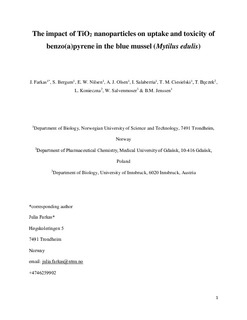| dc.contributor.author | Farkas, Julia | |
| dc.contributor.author | Bergum, Signe | |
| dc.contributor.author | Nilsen, Emil Wear | |
| dc.contributor.author | Olsen, Anders Johny | |
| dc.contributor.author | Salaverria-Zabalegui, Iurgi Imanol | |
| dc.contributor.author | Ciesielski, Tomasz Maciej | |
| dc.contributor.author | Baczek, Tomasz | |
| dc.contributor.author | Konieczna, Lucyna | |
| dc.contributor.author | Salvenmoser, Willi | |
| dc.contributor.author | Jenssen, Bjørn Munro | |
| dc.date.accessioned | 2017-10-09T08:09:11Z | |
| dc.date.available | 2017-10-09T08:09:11Z | |
| dc.date.created | 2015-01-20T10:26:03Z | |
| dc.date.issued | 2015 | |
| dc.identifier.citation | Science of the Total Environment. 2015, 511 469-476. | nb_NO |
| dc.identifier.issn | 0048-9697 | |
| dc.identifier.uri | http://hdl.handle.net/11250/2459097 | |
| dc.description.abstract | Nanoparticles are emerging contaminants of concern. Knowledge on their environmental impacts is scarce, especially on their interactive effects with other contaminants. In this study we investigated effects of titanium dioxide nanoparticles (TiO2NP) on the blue mussel (Mytilus edulis) and determined their influence on the bioavailability and toxicity of benzo(a)pyrene (B(a)P), a carcinogenic polyaromatic hydrocarbon (PAH). Blue mussels were exposed to either TiO2NP (0.2 and 2.0 mg L− 1) or B(a)P (20 μg L− 1) and to the respective combinations of these two compounds. Aqueous contaminant concentrations, the uptake of Ti and B(a)P into mussel soft tissue, effects on oxidative stress and chromosomal damage were analyzed. The uncoated TiO2NP agglomerated rapidly in the seawater. The presence of TiO2NP significantly reduced the bioavailability of B(a)P, shown by lowered B(a)P concentrations in exposure tanks and in mussel tissue. The activities of antioxidant enzyme superoxide dismutase (SOD), catalase (CAT) and glutathione peroxidase (GPx) were impacted by the various exposure regimes, indicating oxidative stress in the contaminant exposure groups. While SOD activity was increased only in the 0.2TiO2NP exposure group, CAT activity was enhanced in both combined exposure groups. The GPx activity was increased only in the groups exposed to the two single compounds. In hemocytes, increased chromosomal damage was detected in mussels exposed to the single compounds, which was further increased after exposure to the combination of compounds. In this study we show that the presence of TiO2NP in the exposure system reduced B(a)P uptake in blue mussels. However, since most biomarker responses did not decrease despite of the lower B(a)P uptake in combined exposures, the results suggest that TiO2NP can act as additional stressor, or potentially alters B(a)P toxicity by activation. | nb_NO |
| dc.language.iso | eng | nb_NO |
| dc.publisher | Elsevier | nb_NO |
| dc.rights | Attribution-NonCommercial-NoDerivatives 4.0 Internasjonal | * |
| dc.rights.uri | http://creativecommons.org/licenses/by-nc-nd/4.0/deed.no | * |
| dc.title | The impact of TiO2 nanoparticles on uptake and toxicity of benzo(a)pyrene in the blue mussel (Mytilus edulis) | nb_NO |
| dc.type | Journal article | nb_NO |
| dc.type | Peer reviewed | nb_NO |
| dc.description.version | acceptedVersion | nb_NO |
| dc.source.pagenumber | 469-476 | nb_NO |
| dc.source.volume | 511 | nb_NO |
| dc.source.journal | Science of the Total Environment | nb_NO |
| dc.identifier.doi | 10.1016/j.scitotenv.2014.12.084 | |
| dc.identifier.cristin | 1202059 | |
| dc.description.localcode | © 2015. This is the authors’ accepted and refereed manuscript to the article. This manuscript version is made available under the CC-BY-NC-ND 4.0 license http://creativecommons.org/licenses/by-nc-nd/4.0/ | nb_NO |
| cristin.unitcode | 194,66,10,0 | |
| cristin.unitname | Institutt for biologi | |
| cristin.ispublished | true | |
| cristin.fulltext | postprint | |
| cristin.qualitycode | 2 | |

